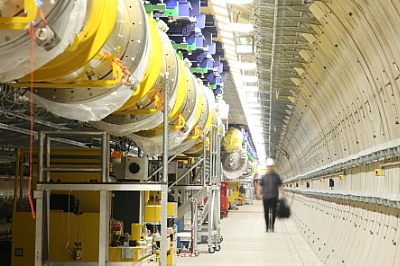HZDR (German) scientists are investigating whether controlled fusion could be facilitated with the assistance of tunneling processes using radiation But that is also a question of energy: the lower it is, the lesser the likelihood of tunneling. Conventional laser radiation intensity was too low to trigger the processes prior to the current work.
XFEL and electron beams to assist fusion reactions
This could all change in the near future: With X-ray free-electron lasers (XFEL) it is already possible to achieve power densities of 10^20 watts per square centimeter. This is the equivalent of approximately a thousand times the energy of the sun hitting the earth, concentrated on the surface of a one-cent coin. “We are now advancing into areas that suggest the possibility of assisting these tunneling processes with strong X-ray lasers,” says Schützhold.
The strong electric field causing the nuclei repulsion is superimposed with a weaker, but rapidly changing, electromagnetic field that can be produced with the aid of an XFEL. The Dresden researchers investigated the process theoretically for the fusion of the hydrogen isotopes deuterium and tritium. This reaction is currently considered to be one of the most promising candidates for future fusion power plants. The results show that it should be possible to increase the tunneling rate in this way; a sufficiently high number of tunneling processes could eventually facilitate a successful, controlled fusion reaction.
Today, just a handful of laser systems around the world with the requisite potential are the flagships of large-scale research facilities, like those in Japan and the United States – and in Germany where the world’s strongest laser of its type, the European XFEL, is to be found in the Hamburg area. At the Helmholtz International Beamline for Extreme Fields (HIBEF) located there, experiments with unique ultra-short and extremely bright X-ray flashes are planned. HZDR is currently in the process of constructing HIBEF.
The Dresden strong field physicists’ next step is to dive even deeper into the theory in order to understand other fusion reactions better and be able to assess their potential for assisting tunneling processes with radiation. Analogous processes have already been observed in laboratory systems, such as quantum dots in solid-state physics or Bose-Einstein condensates, but in nuclear fusion experimental proof is still pending. Thinking yet further ahead, the authors of the study believe other radiation sources could possibly assist tunneling processes. The first theoretical results on electron beams have already been obtained.
Physical Review C – Dynamically assisted nuclear fusion
Researchers consider deuterium-tritium fusion as a generic example for general fusion reactions. For initial kinetic energies in the keV regime, the reaction rate is exponentially suppressed due to the Coulomb barrier between the nuclei, which is overcome by tunneling. Here, we study whether the tunneling probability could be enhanced by an additional electromagnetic field, such as an x-ray free-electron laser (XFEL). They find that the XFEL frequencies and field strengths required for this dynamical assistance mechanism should come within reach of present-day or near-future technology.

Brian Wang is a Futurist Thought Leader and a popular Science blogger with 1 million readers per month. His blog Nextbigfuture.com is ranked #1 Science News Blog. It covers many disruptive technology and trends including Space, Robotics, Artificial Intelligence, Medicine, Anti-aging Biotechnology, and Nanotechnology.
Known for identifying cutting edge technologies, he is currently a Co-Founder of a startup and fundraiser for high potential early-stage companies. He is the Head of Research for Allocations for deep technology investments and an Angel Investor at Space Angels.
A frequent speaker at corporations, he has been a TEDx speaker, a Singularity University speaker and guest at numerous interviews for radio and podcasts. He is open to public speaking and advising engagements.


For a payday worth $trillions I would expect a few people would be interested.
Fusion power long ago jumped the shark when it promised that in a “few short years” it would be producing endless power from Sea Water. Deuterium and Tritium?
Meanwhile fission reactors are becoming safer and more reliable and burn their own wastes and can ride on the back of a semi.
Stop spending money on never never land.
megajoule laser systems aren’t cheap enough to play around with.
Seems like this should work at about the point where they’re dumping in as much laser energy as the anticipated fusion yield. Which, given laser efficiency and the efficiency of the power conversion, would be a total loser in terms of engineering breakeven.
That is the perfect prediction of the expected outcome!!!
That would be 2nd time after July 1943.
Sometimes it seems like German fusion attempts exist for the sole purpose of highlighting the simplicity of fission reactors.
An unanticipated instability due to a density discontinuity, hinders uniform compression.
It is good that there are some completely different possible routes to Fusion.
Because clearly relying on just one route is going to take centuries.
It wasn’t even the laser power. It was the power density.
So 10**20/cm2… but only over a square nanometre or something.
Otherwise Hamburg is (briefly!) classified as a Kardashev 1 level city…
Laser power have been increasing exponentially for a while now. I am surprised that there hasn’t been a break thru on laser fusion.
I dislike when laser power is described as astonishingly, positively, stellar in magnitude while laser energy is not mentioned.
Yeah power is 10**20/cm2 for a bazillionth of a femto-second at 1 shot per day or whatever details omitted.